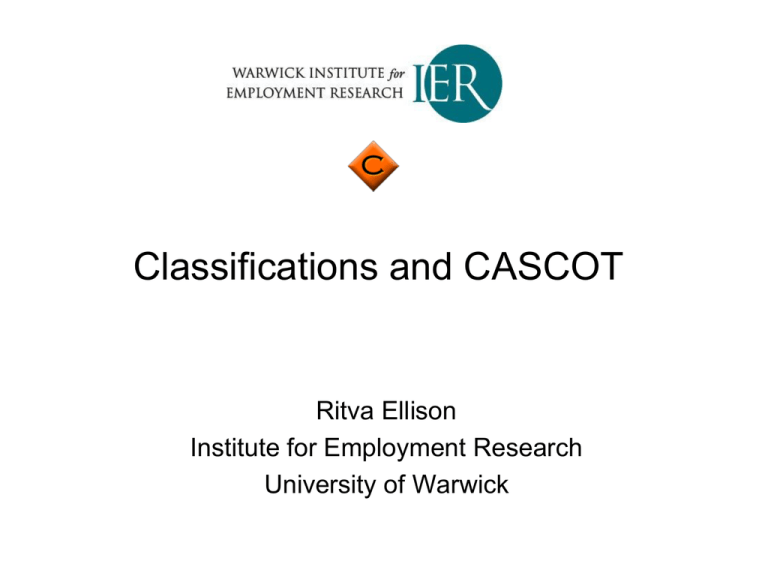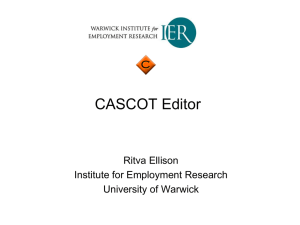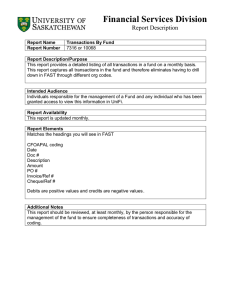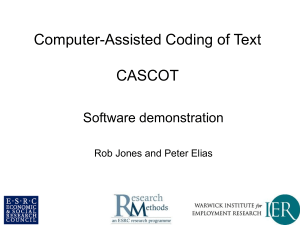Classifications and CASCOT Ritva Ellison Institute for Employment Research University of Warwick
advertisement

Classifications and CASCOT Ritva Ellison Institute for Employment Research University of Warwick Coding text to a classification • Coding is the process of categorising the range of all possible answers to a pre-defined set of categories. • The full set of categories is termed a classification. Examples are: – SOC 2010 (UK Standard Occupational Classification 2010) – ISCO 08 (International Standard Classification of Occupations 2008) – SIC 2007 (UK Standard Industrial Classification 2007) • Three parts to a classification: the structure, the index and the classification rules In total 369 Unit Groups Structure In total 27,738 index entries Index Rules Manual coding procedures • Manual methods – code books; – temporary labour; – query resolution systems. • No standardised approach, major variations between institutions, companies, etc. in quality of coding. • Time-consuming, expensive. Computer Assisted Structured Coding Tool CASCOT Development of software CASOC: Pascal/C++ text coding software for DOS 1993 – 2001. CASCOT: Java text coding software for any operating system. CASOC was ad hoc development, funded from sales revenue. CASCOT initially funded by ESRC, now funded via sales income. Occupational coding in practice • Quality of coding reflects quality of text available for coding. • Need rules which specify how to deal problems such as ambiguous job titles (e.g. engineer, teacher). • Need to be aware that machine coding of text can introduce bias. • Need to establish ‘trade off’ between accuracy and cost. Coding with Cascot • Cascot will provide: A list of recommendations. Code, title, best matching index entry, and certainty score • Certainty Score Approximates the probability that the recommended code is correct. This is represented by a number in the range 0-100. People never 100% right. Computer can’t be 100% right. catering manager Type job title Press enter, or click ‘Code’ button Recommendations Table Classification Structure Index Entries Output Best recommendation selected automatically Select another by clicking a different line OR: Change selection via structure Accept the selection Large scale coding An experienced person can code manually about 100 occupations/hour maintaining a good level of quality What if they need to code a file of 100,000 occupational texts? Use input/output files and automated coding Using files • Instead of typing every job title in, we can read them from a file. • Rather than having to copy the code produced by Cascot we can have Cascot save the codes (and other output) to a file. Example: Using Files Input file (tab delimited). Choose Output Items Click Edit Available Items Example: Using Files Output file (Output items = “Input Record, Code, Title, Score”) Automated coding • Rather than choosing manually the best recommendation every time we can automate the process • Automation options – fully manual – semi-automatic, select the certainty level (manual coding when score is below the level) – fully automatic A fully automated run • How good is this? • Example: – 19,087 unique job titles – Coded fully automatically, sorted descending by certainty score – Selections from output file shown – Wrong codes coloured with light orange How do I make use of the comparison score? Tests with large datasets give us an indication of the accuracy of the coding done by Cascot. Above 80: coding takes place automatically 60 - 80: reasonably sure that the code shown is the correct one to allocate – but need to look at the alternatives shown with slightly lower comparison scores and check against the additional information you have for coding. 40 - 60: there is some ambiguity. Careful consideration of all relevant information is required. 39 and lower: Cascot is struggling to find an appropriate match. More information is necessary before coding can be concluded. Making use of additional information Click to see input record



